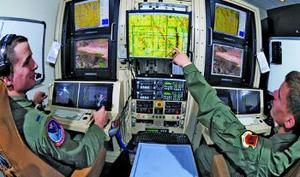Increased use of UAVs in border protection hobbled by shortage of UAV pilots
As hopes that SBInet, the ambitious virtual fence project along the U.S.-Mexico border, will ever live up to its promise recede, DHS has increased the role of UAVs in border monitoring; UAVs require pilots to fly them remotely, though, and Customs and Border Protection (CBP) has had trouble finding trained pilots remotely to fly the aircraft; Maj. Gen. Michael Kostelnik, assistant commissioner of CBP’s Air and Marine Office: “The greatest near-term challenge faced is a shortage of pilots and sensor operators, specifically pilots certified to launch and land the aircraft”

UAV pilots at work // Source: darkgovernment.com
SBInet, the ambitious project to build a virtual fence — consisting of sensors, CCTVs, radar, and other surveillance technologies — along the U.S.-Mexico border is facing an uncertain future. The technology undergriding the project has been judged a failure, and continuing delays and cost overruns have led DHS to freeze the funds for the project’s continuation pending a thorough review.
Both DHS and legislators have been promoting the idea of relying on UAVs to do the monitoring job SBInet was supposed to do (“DHS looking to UAVs to bolster border security,” 22 June 2010 HSNW; and “More UAVs, personnel, money for U.S.-Mexico border protection,” 25 June 2010 HSNW).
Indeed, Nextgov’s Jill R. Aitoro writes that the Customs and Border Protection (CBP) has increasingly been relying more on unmanned aerial vehicles to patrol the U.S. borders, but the bureau has had trouble finding trained pilots remotely to fly the aircraft, a DHS official told Congress yesterday.
The use of UAVs has expanded from primarily the military to homeland security, with CBP using the vehicles to scan the border for illegal immigrants and to support disaster relief operations. DHS patrols parts of both the southern and northern U.S. land borders as well as the maritime border, armed with long-range detection and tracking capabilities. CBP plans to steadily expand their use in coming years, and the Coast Guard also is investigating how it can use the aircraft.
“The greatest near-term challenge faced is a shortage of pilots and sensor operators, specifically pilots certified to launch and land the aircraft,” AFP quotes Maj. Gen. Michael Kostelnik, assistant commissioner of CBP’s Air and Marine Office, to say. “There is a significant amount of competition among the DoD, industry and DHS to hire [UAV] pilots.” He testified before the House Subcommittee on Border, Maritime and Global Counterterrorism.DHS operates the unmanned vehicles from four control stations in Riverside, California; Sierra Vista, Arizona; Grand Forks, North Dakota; and Cape Canaveral, Florida.
Aitoro notes that to date, CBP has acquired seven aircraft, and has included funding for an eighth in its fiscal 2011 budget request. On 23 June, the Federal Aviation Administration (FAA) approved the flight of a UAV over 1,200 miles of the Texas-Mexico border, which allowed CBP to move forward with plans to permanently station one in the state and establish an additional control site at the Naval Air Station in Corpus Christi, Texas.
“The limits aren’t related to the aircraft right now. It’s really the pilots — the manned portion” of the program, said Kostelnik, who added two pilots should be stationed at the control station to support each aircraft.
In fiscal 2009 CBP received funds to hire twenty-four pilots. Of those hired, only a few had significant experience with unmanned aerial systems, he said. The others currently are being trained. CBP does not plan to hire additional pilots in fiscal 2011 except to replace any pilots who retire, Kostelnik added.
“UAVs are a force multiplier for our federal, state and local law enforcement as they provide the intelligence to help detect, disrupt and dismantle unlawful activity along our borders,” said subcommittee Chairman Henry Cuellar (D-Texas). “[But] training pilots to fly these [vehicles] at home has proved difficult at a time when similar aircraft are being used in the wars in Iraq and Afghanistan. We need to examine the challenges of training these pilots, the time it takes and what the necessary means are for fulfilling the future of this program.”
A number of subcommittee members encouraged Defense and DHS to share resources to support both departments UAV programs. Kostelnik conceded the recent establishment of a UAV executive steering committee with representatives from Defense, FAA, DHS, and NASA should address the need for governmentwide access to pilots and other resources.
